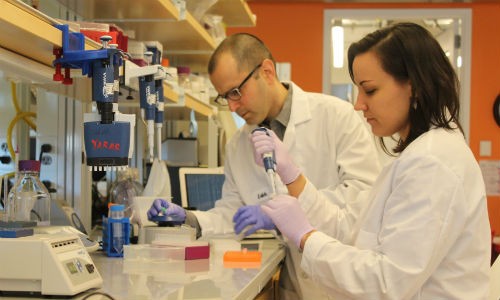By Ana Verayo, | March 05, 2017

This DNA storage process can be expensive, however, further research and technological applications will improve this feasibility. (New York Genome Center)
Human DNA can store massive amounts of data which can be replicated and transmitted. Now, scientists say the DNA can be transformed into an actual hard drive of a computer that can successfully store and retrieve digital files including a movie file and an operating system.
In a new study by a team from the New York Genome Center and Columbia University, researchers selected five files that had an operating system, a movie file, and a virus from a computer then compressed them together into one master file. This master file was then transformed into binary code that possessed ones and zeroes.
Like Us on Facebook
Researchers collected these binary code strings known as "droplets" of fountain code. These droplets were then converted into four DNA nucleotide bases with letters replacing the ones and zeroes. The team also used an algorithm to correct erasures to make sure that letter combinations will not contain any errors when used. Each droplet was assigned with a bar code so that file retrieval and reorganization will be easier.
The entire DNA coding process took 72,000 DNA strands with 200 bases long. The DNA file was then sent to a startup based in San Francisco, California called Twist Bioscience to transform this digital DNA into a biological one. After a span of two weeks, researchers received organic DNA strands inside a vial.
Computer scientist Yaniv Erlich from Columbia Engineering and Dina Zielinski from the New York Genome Center used a standard DNA sequence software to transform this DNA file into a digital one. This unique program helped in translating these nucleotide sequences into binary code where the team discovered no coding errors.
For the first time, 215 petabytes of data were stored within a single gram of DNA, setting a new record. "This is the highest density data storage device we have ever created," Erlich said.
Scientists were also successful at replicating these DNA strands along with the digital files embedded within, into a polymerase chain reaction without any coding error. This DNA storage process can be expensive, however, further research and technological applications will improve this feasibility.
This new study was published in the journal Science.
-
Use of Coronavirus Pandemic Drones Raises Privacy Concerns: Drones Spread Fear, Local Officials Say

-
Coronavirus Hampers The Delivery Of Lockheed Martin F-35 Stealth Fighters For 2020

-
Instagram Speeds Up Plans to Add Account Memorialization Feature Due to COVID-19 Deaths

-
NASA: Perseverance Plans to Bring 'Mars Rock' to Earth in 2031

-
600 Dead And 3,000 In The Hospital as Iranians Believed Drinking High-Concentrations of Alcohol Can Cure The Coronavirus

-
600 Dead And 3,000 In The Hospital as Iranians Believed Drinking High-Concentrations of Alcohol Can Cure The Coronavirus

-
COVID-19: Doctors, Nurses Use Virtual Reality to Learn New Skills in Treating Coronavirus Patients







